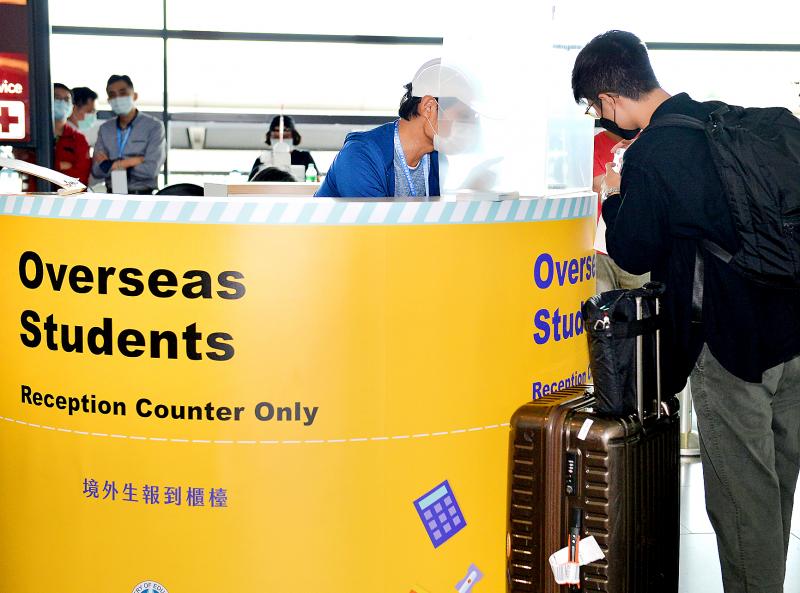More than 100 people who had close contact with a Japanese student who tested positive for COVID-19 on her arrival in Japan from Taiwan are to have their blood tested to see if they have developed antibodies for the virus, the Central Epidemic Command Center (CECC) said yesterday, after all of them tested negative for the virus.
The student arrived in late February to attend classes in southern Taiwan. She tested positive for the virus upon arrival at Narita Airport on Saturday last week.
The case was reported by the center on Wednesday.

Photo: Chu Pei-hsiung, Taipei Times
As the source of her infection is not clear, the CECC has not given the case a number.
The 123 people who had close contact with the woman, including teachers and former roommates, have been ordered to isolate at home.
On Monday, the center is to conduct blood tests on the 123 people to see whether they have been infected, Centers for Disease Control (CDC) Deputy Director-General Chuang Jen-hsiang (莊人祥) told a news conference in Taipei.
A polymerase chain reaction test in Japan showed that the woman’s cycle threshold (CT) reading was between 37 and 38, which is considered “slightly positive” by Taiwan’s standards, Chuang said.
Scientists have yet to arrive at a consensus over what CT value should constitute a confirmed case, he said.
It is possible that the result from the test done in Japan is not reliable, given that people who had close contact with her have all tested negative so far, he said, adding that it was possible that she was infected in Taiwan one or two months ago, or even earlier.
As of yesterday, Taiwan had reported 447 cases, with seven fatalities, CECC data showed.
They comprised 356 imported cases, 55 local cases and 36 among crew members on the navy supply ship Panshih (磐石), the data showed.
In related news, eight foreign students arrived yesterday at Taiwan Taoyuan International Airport and began 14 days of isolation, the Ministry of Education said.
They are among the first batch of 2,238 students allowed to re-enter Taiwan after the center last week announced a list of 11 low-risk countries or regions from which students can return to study in Taiwan, with those planning to graduate this semester prioritized.
The places are Australia, Bhutan, Brunei, Fiji, Hong Kong, Macau, Mongolia, Thailand, New Zealand, Palau and Vietnam.
On Thursday, the airport reopened for transit passengers whose stay is scheduled for less than eight hours. Seven travelers from the Philippines arrived at the airport yesterday on transit stops before flights to three cities in the US.
Additional reporting by CNA

The US government has signed defense cooperation agreements with Japan and the Philippines to boost the deterrence capabilities of countries in the first island chain, a report by the National Security Bureau (NSB) showed. The main countries on the first island chain include the two nations and Taiwan. The bureau is to present the report at a meeting of the legislature’s Foreign Affairs and National Defense Committee tomorrow. The US military has deployed Typhon missile systems to Japan’s Yamaguchi Prefecture and Zambales province in the Philippines during their joint military exercises. It has also installed NMESIS anti-ship systems in Japan’s Okinawa

‘WIN-WIN’: The Philippines, and central and eastern European countries are important potential drone cooperation partners, Minister of Foreign Affairs Lin Chia-lung said Minister of Foreign Affairs Lin Chia-lung (林佳龍) in an interview published yesterday confirmed that there are joint ventures between Taiwan and Poland in the drone industry. Lin made the remark in an exclusive interview with the Chinese-language Liberty Times (the Taipei Times’ sister paper). The government-backed Taiwan Excellence Drone International Business Opportunities Alliance and the Polish Chamber of Unmanned Systems on Wednesday last week signed a memorandum of understanding in Poland to develop a “non-China” supply chain for drones and work together on key technologies. Asked if Taiwan prioritized Poland among central and eastern European countries in drone collaboration, Lin

BACK TO WORK? Prosecutors said they are considering filing an appeal, while the Hsinchu City Government said it has applied for Ann Kao’s reinstatement as mayor The High Court yesterday found suspended Hsinchu mayor Ann Kao (高虹安) not guilty of embezzling assistant fees, reducing her sentence to six months in prison commutable to a fine from seven years and four months. The verdict acquitted Kao of the corruption charge, but found her guilty of causing a public official to commit document forgery. The High Prosecutors’ Office said it is reviewing the ruling and considering whether to file an appeal. The Taipei District Court in July last year sentenced Kao to seven years and four months in prison, along with a four-year deprivation of civil rights, for contravening the Anti-Corruption

NO CONFIDENCE MOTION? The premier said that being toppled by the legislature for defending the Constitution would be a democratic badge of honor for him Premier Cho Jung-tai (卓榮泰) yesterday announced that the Cabinet would not countersign the amendments to the local revenue-sharing law passed by the Legislative Yuan last month. Cho said the decision not to countersign the amendments to the Act Governing the Allocation of Government Revenues and Expenditures (財政收支劃分法) was made in accordance with the Constitution. “The decision aims to safeguard our Constitution,” he said. The Constitution stipulates the president shall, in accordance with law, promulgate laws and issue mandates with the countersignature of the head of the Executive Yuan, or with the countersignatures of both the head of the Executive Yuan and ministers or